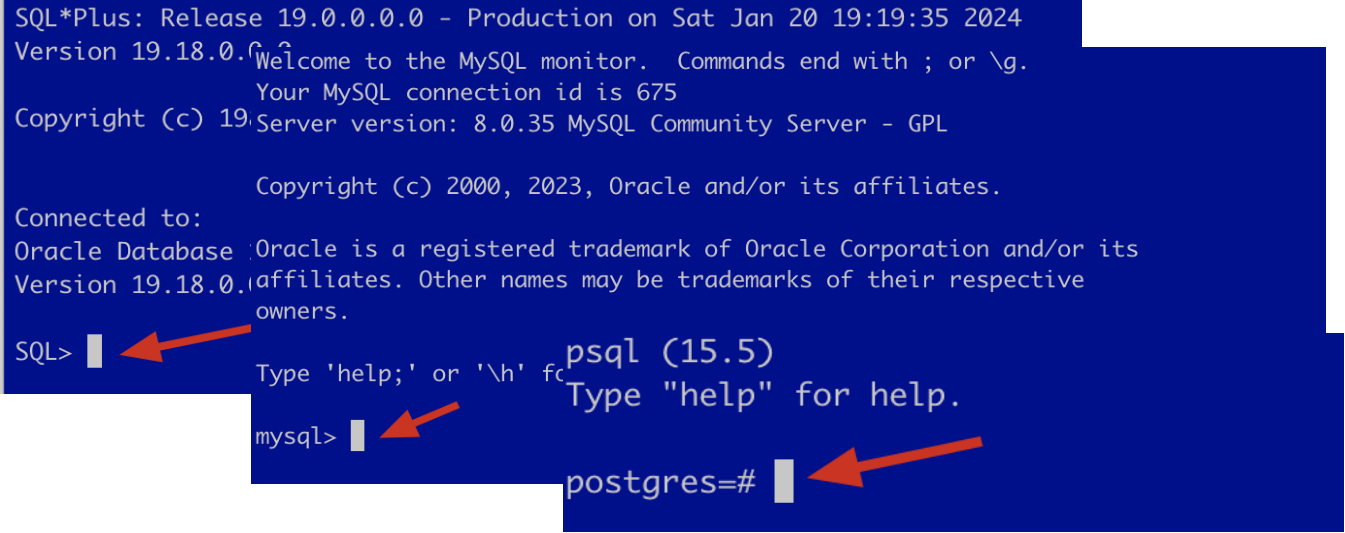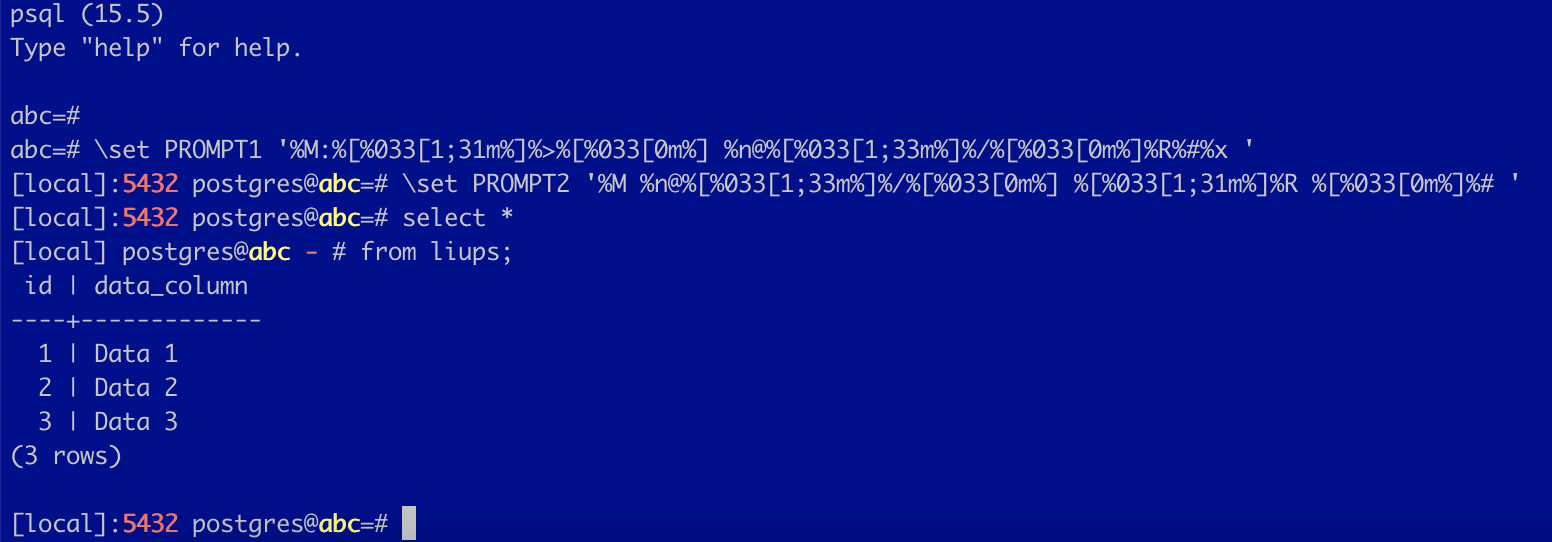Table of Contents
ORACLE、MySQL、PostgreSQL 客户端 sqlplus,mysql,psql 常用命令对比(二)
这是系列文章:
ORACLE、MySQL、PostgreSQL 客户端 sqlplus,mysql,psql 常用命令对比(一)
ORACLE、MySQL、PostgreSQL 客户端 sqlplus,mysql,psql 常用命令对比(二)
上接:ORACLE、MySQL、PostgreSQL 客户端 sqlplus,mysql,psql 常用命令对比(一),在对比了客户端的安装以及连接数据库的区别。
现在连接上数据库之后就是进一步的操作了,然而连上数据库之后首先看到的就是提示符,那本篇就从定制提示符开始吧。
本来之前都是通过一种方式来配置提示符,没想到提示符的配置也比较复杂,mysql 竟然可以通过3种方式来实现。那这篇文章就讲一下三种数据库的提示符相关的配置吧。
默认提示符
默认情况下 sqlplus、mysql、psql 的提示符都很简单,如下:

sqlplus 默认提示符为: SQL>
mysql 默认提示符为:mysql>
psql 默认提示:[dbname]=# 默认的数据库是postgres 即postgres=#
既然要定制提示符,那我们就得知道提示符的配置在哪里,下面是三种数据库的提示符的配置。
提示符配置
sqlplus 提示符配置
sqlplus 提示符配置可以通过配置文件或者通过命令直接修改
配置文件有两种:
一个是全局配置文件(Site Profile) :$ORACLE_HOME/sqlplus/admin/glogin.sql,从任意位置登录sqlplus 都生效
一个是用户配置文件(User Profile):ORACLE_PATH 环境变量下的 login.sql,Note:SQL*Plus will no longer search for login.sql in the current directory. 通过查询官方手册(https://docs.oracle.com/cd/E11882_01/server.112/e16604/ch_two.htm#i1133106)发现在11g的版本是当前目录下查找 login.sql,12c之后是依赖ORACLE_PATH 环境变量。但是我在11204版本的时候测试也是依赖ORACLE_PATH 环境变量的。
参考Configuring SQL*Plus 手册 [1]
可以看到 ORACLE 官方写 SQL*Plus User’s Guide and Reference 洋洋洒洒竟然有300多页。
sqlplus 除了修改配置文件之外,也可以通过 SET SQLPROMPT 命令直接指定当前的提示符。
SQL> SET SQLPROMPT "_USER'@'_CONNECT_IDENTIFIER _DATE> "
SYS@ora19cl 2024-01-20 06:24:13>
mysql 提示符配置
mysql 提示符配置文件为:MySQL 配置文件的[mysql]标签,MySQL的配置文件可以存在多个位置依次为:/etc/my.cnf ,/etc/mysql/my.cnf, /usr/local/mysql/etc/my.cnf ,~/.my.cnf
同样 mysql 除了通过参数文件设置 提示符之外,也可以直接通过prompt set \u@\d \r:\m:\s> 直接设置,他跟参数文件的配置有一点区别,配置文件是 key = value 的形式,比如:prompt = "\u@mysqldb \R:\m:\s [\d]> "但是通过命令行设置是 prompt set \u@\d \r:\m:\s>。
mysql 除了通过配置参数文件、命令行直接修改之外也可以通过 mysql --prompt 来指定,类似如下:
mysql --prompt="\u@iasmmysql currentdb is [\d]> "
实际上在写这篇文章的时候,我只知道是通过参数文件来进行配置的,但是为了这篇文章,我又重新查看了官方手册,发现是可以通过3 种方式实现的:
You can set the prompt in several ways:
-
Use an environment variable. You can set the
MYSQL_PS1environment variable to a prompt string. For example:export MYSQL_PS1="(\u@\h) [\d]> " (liups@127.0.0.1) [mesdb]> -
Use a command-line option. You can set the
--promptoption on the command line to mysql. For example:$> mysql --prompt="(\u@\h) [\d]> " (liups@127.0.0.1) [mesdb]> -
Use an option file. You can set the
promptoption in the[mysql]group of any MySQL option file, such as/etc/my.cnfor the.my.cnffile in your home directory. For example:[mysql] prompt=(\\u@\\h) [\\d]>\\_
其中 mysql 的提示符竟然可以通过 OS 的 MYSQL_PS1 变量来设置。
psql 提示符配置
psql 提示符配置文件:~/.psqlrc 也就是当前用户的家目录下 .psqlrc 文件。
定制提示符
定制 sqlplus 提示符
ORACLE 的 sqlplus 提示符是由 SQLPROMPT 控制的,通过 show SQLPROMPT 可以查看当前的默认配置,
SQL> show SQLPROMPT
sqlprompt "SQL> "
可以看到目前的提示符就是SQL>,可以通过define可以查看当前的提示符的系统变量。
SQL> define
DEFINE _DATE = "2024-01-19 20:18:24" (CHAR)
DEFINE _CONNECT_IDENTIFIER = "dbo19c_high" (CHAR)
DEFINE _USER = "ADMIN" (CHAR)
DEFINE _PRIVILEGE = "" (CHAR)
DEFINE _SQLPLUS_RELEASE = "1918000000" (CHAR)
DEFINE _EDITOR = "vi" (CHAR)
DEFINE _O_VERSION = "Oracle Database 19c Enterprise Edition Release 19.0.0.0.0 - Production
Version 19.22.0.1.0" (CHAR)
DEFINE _O_RELEASE = "1922000100" (CHAR)
也就是上面的 _DATE、_CONNECT_IDENTIFIER 等信息是可以直接拿来使用的,可以直接写到配置文件中,首先那我们先看下默认的配置文件的模样。使用cat 命令进行查看。
cat $ORACLE_HOME/sqlplus/admin/glogin.sql
--
-- Copyright (c) 1988, 2005, Oracle. All Rights Reserved.
--
-- NAME
-- glogin.sql
--
-- DESCRIPTION
-- SQL*Plus global login "site profile" file
--
-- Add any SQL*Plus commands here that are to be executed when a
-- user starts SQL*Plus, or uses the SQL*Plus CONNECT command.
--
-- USAGE
-- This script is automatically run
--
可以看到这里都是注释,描述的用途和用法,也就是这里的内容会自动运行。
比如最简单的配置:SET SQLPROMPT "_USER'@'_CONNECT_IDENTIFIER _DATE> "
_DATE :当前时间、_CONNECT_IDENTIFIER 连接标识、_USER:用户名
可以在 sqlplus 直接 通过 set SQLPROMPT 设置对当前session生效,也可以修改配置文件永久生效。
SET SQLPROMPT "_USER'@'_CONNECT_IDENTIFIER _DATE> "
美化后的效果如下:
SYS@ora19cl 2024-01-19 22:02:13>
可以能当前时间太长,可以去掉,就使用SET SQLPROMPT "_USER'@'_CONNECT_IDENTIFIER> "
美化效果如下:
SQL> SET SQLPROMPT "_USER'@'_CONNECT_IDENTIFIER> "
SYS@ora19cl>
其中配置文件和通过命令直接设置的语法是一致的。都是 set SQLPROMPT
以上是通过拼接系统自带的变量来进行定制,实际上 还支持通过 sql 语句进行拼接。
以下定制提示符是转自:OracleBlog – 笑看数据库江湖的那些事儿……的 12c的sqlplus提示符,就是根据sql 语句查询出当前的数据库是PDB还是PDB等信息。
define_editor=vi
set timing on
set serveroutput on size 100000
set linesize 100
set trimspool on
set long 5000
set termout off
default gname=idle
column global_name new_value gname
SELECT lower(USER) || '@' ||
case (select cdb from v$database)
when 'NO' then
(select upper(instance_name) from v$instance) || '[NON-CDB]'
when 'YES' then
decode(sys_Context('userenv', 'con_Name'),
'CDB$ROOT',
(select upper(instance_name) from v$instance) || '[CDB]',
sys_Context('userenv', 'con_Name') || '[PDB]')
end || '(' ||
nvl(UTL_INADDR.GET_HOST_ADDRESS,
SYS_CONTEXT('userenv', 'ip_address')) || ')' GLOBAL_NAME
FROM v$instance;
set sqlprompt '&gname> '
set termout on
效果如下:
CDB
sys@ORCL1[CDB](172.20.22.127)>
PDB
sys@PDBMES[PDB](172.20.22.127)>
可以显示用户,登录的PDB/CDB 数据库,并且增加了 CDB/PDB的标识,并且还显示当前的ip信息。可以说是非常完善了。
定制 mysql 提示符
prompt 命令用于重新配置默认的 mysql> 提示符,可用于定义提示符的字符串可以包含以下特殊序列。
下面表格引用自 mysql Client Commands 官方手册 [2] 。
| Option | Description |
|---|---|
\C |
The current connection identifier |
\c |
A counter that increments for each statement you issue |
\D |
The full current date |
\d |
The default database |
\h |
The server host |
\l |
The current delimiter |
\m |
Minutes of the current time |
\n |
A newline character |
\O |
The current month in three-letter format (Jan, Feb, …) |
\o |
The current month in numeric format |
\P |
am/pm |
\p |
The current TCP/IP port or socket file |
\R |
The current time, in 24-hour military time (0–23) |
\r |
The current time, standard 12-hour time (1–12) |
\S |
Semicolon |
\s |
Seconds of the current time |
\T |
Print an asterisk (*) if the current session is inside a transaction block (from MySQL 8.0.28) |
\t |
A tab character |
\U |
Your full *user_name*@*host_name* account name |
\u |
Your user name |
\v |
The server version |
\w |
The current day of the week in three-letter format (Mon, Tue, …) |
\Y |
The current year, four digits |
\y |
The current year, two digits |
\_ |
A space |
\ |
A space (a space follows the backslash) |
\' |
Single quote |
\" |
Double quote |
\\ |
A literal \ backslash character |
\*x* |
x, for any “x” not listed above |
虽然 mysql 的提示符支持30个选项,其实真正需要的就那么几个比如,用户、数据库、时间、主机等。
用户区分 /U和/u ,其中 /U :完整的用户名@hostname形式。
mes@iasmmysql currentdb is [mesdb] mes@localhost >
prompt = "\u@mysqldb \R:\m:\s [\d]> "
mysql 通过配置文件和命令行设置是有区别的,上面有写,这个需要注意。
这里单独看一下export MYSQL_PS1="(\u@\h) [\d]> ",这是操作系统一个变量,可以用来配置mysql 客户端的提示符,这个跟 OS 的 PS1 类似。
定制 psql 提示符
psql 是通过配置.psqlrc文件(linux平台)来定制 psql 提示符。
.psqlrc文件
cd
vi .psqlrc 对配置文件进行编辑,有3个变量 PROMPT1,PROMPT2 和 PROMPT3 进行控制。
PROMPT1 是 psql 请求一个新命令时的使用的正常提示符。
PROMPT2 是在一个命令输入期待更多输入时(因为查询没有用一个分号结束或者引号没有关闭)显示的提示符。
PROMPT3 在你运行一个 SQL COPY 命令和等待你在终端上键入记录时使用。
常用的选项有下面几个,来自官方手册 [3]
- %M The full host name (with domain name) of the database server, or [local] if the connection is over a Unix domain socket, or [local:/dir/name], if the Unix domain socket is not at the compiled in default location.
- %> The port number at which the database server is listening.
- %n The database session user name. (The expansion of this value might change during a database session as the result of the command SET SESSION AUTHORIZATION.)
- %/ The name of the current database.
- %# If the session user is a database superuser, then a #, otherwise a >. (The expansion of this value might change during a database session as the result of the command SET SESSION AUTHORIZATION.)
- %x Transaction status: an empty string when not in a transaction block, or * when in a transaction block, or ! when in a failed transaction block, or ? when the transaction state is indeterminate (for example, because there is no connection).
\set PROMPT1 '%`date +%H:%M:%S` (%n@%M:%>)%/%R%#%x'
\set PROMPT2 '%M %n@%/%R %# '
20:38:04 (postgres@[local]:5432)postgres=#
psql 与众不同的一点是可以设置颜色
\set PROMPT1 '%M:%[%033[1;31m%]%>%[%033[0m%] %n@%[%033[1;33m%]%/%[%033[0m%]%R%#%x '
\set PROMPT2 '%M %n@%[%033[1;33m%]%/%[%033[0m%] %[%033[1;31m%]%R %[%033[0m%]%# '
效果如下图所示:

其中端口号设置红色,数据库的名称设置为黄色,PROMPT2 未完成的查询有红色的 - 代替了原来的 =。
总结:
三种数据库的提示符都可以通过在当前session 进行设置,其中 :
sqlplus 是SET SQLPROMPT;
mysql 是:prompt set \u@\d \r:\m:\s>;
psql 是:\set PROMPT1 '%date +%H:%M:%S(%n@%M:%>)%/%R%#%x'。
注意⚠️: sqlplus 是 SET SQLPROMPT,mysql 是 prompt set,关键词一个是 SQLPROMPT 一个是 prompt,其中 sqlplus 是 set 在前,mysql 是 set在后,而psql 呢,又不一样,他set的时候需要前面有一个 \ 然后 set PROMPT1/PROMPT3/PROMPT3`,有3个关键词。
提示符的格式基本上是:用户、库名、时间、连接方式等的拼接,oracle 的sqlplus 提示又比较复杂支持通过sql语句进行拼接。
plsql 是支持设置不同的颜色,目前没有发现 sqlplus 和mysql 支持定制颜色。






